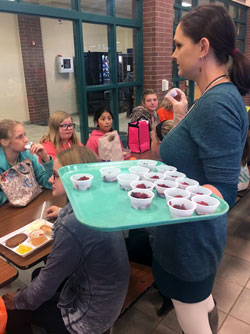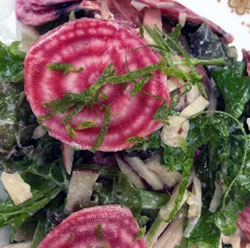If Jessica Endres, director of dining services for Thornapple Kellogg Schools, has things her way, students across the state of Michigan will all be eating Brussels sprouts and carrots.
Now in their second year of the state-funded 10-Cent Grant program, Endres and the rest of the Thornapple Kellogg dining staff have been serving up fresh, locally-sourced fruits and vegetables to students in West Michigan. Each month, a different Michigan food is featured across the district.

“We’ve served everything from zucchini and butternut squash to Saskatoon berries and radishes,” Endres said.
Through the 10-Cent Grant, schools receive matching incentive funding up to 10 cents per meal to purchase and serve Michigan-grown fruits, vegetables and legumes. Now in its second year, the grant is at work in 27 counties and 57 school districts, serving 134,036 students.
To make some more adventurous foods appealing to students, cafeteria staff members often offer samples to students in the lunch line, Endres said.
“Most kids are open to trying everything, especially if they get to try a sample of it,” she said. “More times than not, they are surprised with how much they like everything.”
In addition to the featured food of the month, a variety of apples grown in Michigan are offered every day across the district.

Garden Club
In conjunction with the fresh food initiative, Endres and Amy Forman, a teacher at the middle school, run a garden club for students interested in cooking and gardening.
Students learned how to cut, cook and prepare dishes with beets, apples, goat cheese, lettuce and basil during the first meeting of the club. After some lessons in the kitchen, students made candy cane beet and apple salad with goat cheese lime dressing and candy cane beet root chips.
“It was a great first kitchen cooking lesson for our garden club this week,” Endres said. “All ingredients are locally-sourced, when possible. Students used Michigan grown and cultivated candy cane beets, basil, four different types of artisan leaf lettuce, and goat cheese from a Michigan goat creamery.”
Kailee Ancel, an eighth grade student and member of the garden club, likes using fresh ingredients she hasn’t used in the kitchen before.
“I like that we are learning about gardening and how to grow our own food,” she said. “We’re cooking with fresh ingredients that I haven’t tried before – it’s fun.”

Looking Ahead
Right now, all Michigan-sourced food is ordered through Cherry Capital Foods in Traverse City. With every order, a list comes that shows which Michigan farm the food is coming from.
“There’s a real difference between food that has traveled two hours and food that has traveled three days or sat in a warehouse somewhere,” Endres said. “What they’re getting is more nutritious and tastes better, therefore, students are more likely to eat the food again because it’s not a tomato that’s red but has no flavor.”
Some foods are also harvested from the school gardens.By next year, Endres hopes to have raised beds in the gardens for more produce.
Looking back at the past years of the program, Endres has seen a change in student reactions to new foods on the menu.
As the 10-cent Grant program moves forward, Endres hopes to start serving Michigan products as entrees, in addition to sides, she said.
“I attended the School Nutrition Industry Conference of Michigan for a vendor show and I saw a company that does spice packs and another company that sells Michigan chickpeas. I would love to do something like that,” she said.
Endres is continuing to look at what other schools across the state are doing for fresh food integration. “I think it’s important that food service directors and the state continues to advocate for this program to continue,” she said.
“This is something that will benefit the kids throughout their entire lives. Having exposure to what healthy, fresh food tastes like is a must.”
CONNECT
What’s for lunch today? Check your phone










